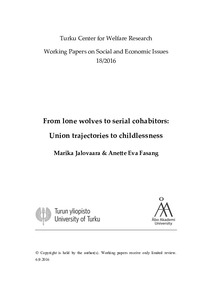From lone wolves to serial cohabitors: Union trajectories to childlessness
Jalovaara Marika; Fasang Anette
https://urn.fi/URN:NBN:fi-fe2021042716168
Tiivistelmä
Background
Childlessness has increased in many European countries. Partnerships and parenthood are obviously closely related, but there is relatively little knowledge on how childlessness is linked to contemporary union dynamics involving high rates of separation and unmarried cohabitation.
Objective
To situate childlessness in longitudinal dynamics of union formation and stability, we take a holistic life-course approach to union trajectories that consist of states entered via the formation and dissolution of cohabitations and marriages. Concretely, we identify the typical union pathways (from age 18–39) of individuals that are childless at age 42.
Methods
We analyse register data on Finnish men and women born 1969 and 1970 (childless N=3,241) with sequence, cluster and multinomial logistic regression methods.
Results
Four typical union pathways were identified among the childless: Lone wolves (45%), characterised by never having entered a co-residential partnership, or just having entered a cohabitation near age 40; Briefly cohabited (25%), characterised by mostly living singly after a brief cohabitation spell, Cohabitors, often serial (19%), marked by typically discontinuous cohabitation; and Married (11%). Men, persons with a rural background, and the lowest and highest educated, are overrepresented among the Lone wolves childless.
Conclusion
For the great majority of childless in our study cohorts, union trajectories are marked by either (almost) complete absence of co-residential unions, or fragmentary cohabitation histories.
Contribution
The study contributes to the literature by showing that union histories, including never partnering as well as cohabitation instability, are key for understanding contemporary childlessness.
Kokoelmat
- Rinnakkaistallenteet [27094]
